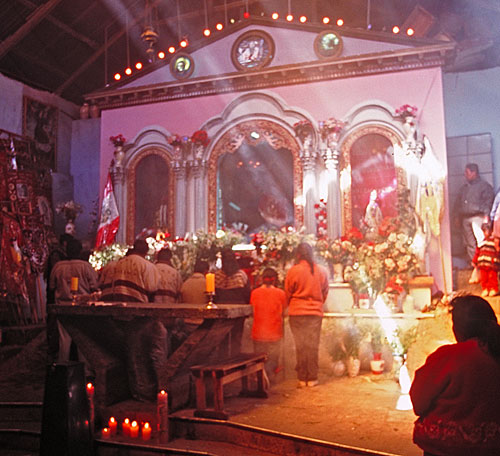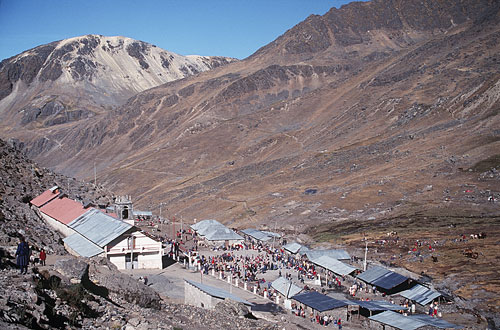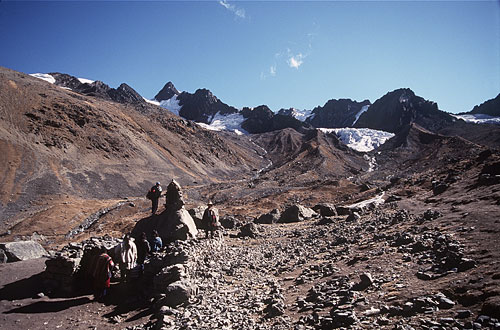
Interior of Church, Festival site of Qoyllorit'i
The worship and religious use of high mountains is widespread and of great antiquity in the Andes. Archaeological research has revealed more than 50 ceremonial sites on or near high mountain summits in Colombia, Ecuador, Peru, Bolivia, and Chile (scholars have climbed and investigated nearly 100 mountains over 5,200 meters). One set of ruins, on the summit Llullaillaco at 6,723 meters, constitutes the world's highest known archaeological site. While most of the archaeological remains found at these sites indicate construction by the Inca (between 1470 and 1532), it is known that the mountains were worshipped for many thousands of years before the arrival of the Inca. As Johan Reinhard explains, "when the Inca entered areas where these beliefs already existed, they apparently felt it necessary to construct ritual sites to help in gaining greater political, religious, and economic control over the people and land they conquered."
Why were mountains worshipped in the ancient Andes? Similar to what we find in mountainous regions throughout the world, the high Andean mountains were believed to be the abodes of deities that controlled the weather, the rains, and the productivity of crops. It is easy to understand how this sort of belief would have developed. Rain clouds were seen to form around the summits of the high peaks, and streams and springs flowed downward from the mountain heights. Early humans offered worship to the mountains in hopes of maintaining these flows of life-giving water and also to appease angry weather gods who threw bolts of lightening and crop-destroying hail.
Of widespread importance in the Andes was a Weather God, known as Tunupa to the Aymara of Bolivia, and Illapa to the Inca of Peru. This god controlled rain, snow, hail, storms, lightening, and thunder. While the Inca, for example, had other important deities, including Viracocha (the Creator), Inti (the Sun), and Pachamama (the Earth Mother), scholars generally believe that the various weather gods were the initial, most widespread, and most important of all the Andean deities. In some regions, Pachamama was believed to be the mother of the weather gods, but in others she was understood to be fertilized by them. And worship of the Inti, the Sun god, was primarily a practice of the Inca, introduced long after the time of the storm gods.
Additionally, Andean peoples venerated mountains as being the mythical places where their cultures began, as the abodes of ancestor spirits, the haunts of shamans, the homes of power animals (especially the condor, who was believed to be a manifestation of the mountain gods), and as forming the link between the three worlds of the Underground, Earth and Sky. Readers interested in more detailed information on this subject may consult the writings of Johan Reinhard, listed in the bibliography on this web site.
Two primary Apus, or sacred peaks, Salcantay and Ausungate, dominate the southern mountains of Peru. Archaeological and ethnographical research has revealed that both pre-Inca and Inca people frequented these mountains for ceremonial purposes, and this practice has continued unbroken into present times. Current day religious use of these Apus reflects a fascinating mix of pagan and Christian influences. This is perhaps clearly observable at the mountain shrine of Qoyllur Rit'I, the most venerated holy places of southern Peru.
Located high in the Sinakara valley, near the town of Mahuayani and Ausungate peak (6,372 meters, 20,905 ft.), the shrine of Qoyllur Rit'i derives its sanctity from four separate but interrelated factors. 1) The June date of the annual pilgrimage to the site (and more precisely the pre-Christian sacred day of June 21, the time of the solstice) seems to be associated with the prehistoric, pan-Andean preoccupation with the Pleiades constellation and its association with the wanderings of the mythical pilgrim-hero Wiracocha. 2) The general importance of the sacred mountain, Apu Ausungate, on the side of which the shrine is located. 3) The Pre-Colonial legend that Ausungate has been known to appear to local peasants as a white-skinned boy with blond hair (there are strange parallels here to the physical look of the god Viracocha, said to be a white-haired, blue-eyed man). 4) The Christian legend of how a local shepherd boy, and soon thereafter some church officials from Cuzco, encountered a mysterious Caucasian-appearing youth, assumed to be the child Christ, at the place where the pilgrimage shrine now stands.
The transformation of the previously indigenous religious site into a Catholic pilgrimage began in 1783 when the cult of Senor de Qoyllur Rit'i was launched by the clergy's declaration of Christ's appearance. This trend has continued through the efforts of the church-sanctioned Roman Catholic brotherhood who, as the shrine's custodians, dominate the cult, chapel, and processions of sacred images, and who strive to impart an ever stronger Christian appearance to all the proceedings.
This ancient and multi-cultural use of the sacred site of Qoyllur Rit'i is a clear example of a pattern found throughout Latin America (and indeed the world): the usurpation of one culture's sacred spaces by a conquering culture. The anthropologist Deborah Poole, a specialist in Peruvian pilgrimage studies, elaborates on this theme. "Pilgrimage has enjoyed a prominent status in Andean religion for many centuries. As part of a vast sacred geography, institutionalized cults to such pan-Andean sanctuaries as Pachacamac and Copacabana, as well as those addressed to numerous regional shrines (huacas), formed an integral part of the vast political and economic network linking ethnic chiefdoms and conquered provinces to the Inca capital of Cuzco, itself a religious center of great import. With the arrival of the Spanish hegemony and its attendant Catholic ideology, many of these sanctuaries were transformed, at least in name, into Christian pilgrimage centers housing miraculous images of saints, Virgin Marys, and an assortment of Christ figures".

Festival site of Qoyllorit'i, Mt. Ausungate, Peru
The high mountain shrine of Qoyllur Rit'i is difficult to reach and therefore seldom visited by anyone other than religious pilgrims. A handful of hardy pilgrims trickle to the site during the short period of the Andean summer. On two particular days, in mid-June (during the full moon prior to Corpus Christi) and on September 14, they assemble by the thousands. The June date, the primary festival, is becoming well known due to the studies of anthropologists and the tours offered by travel companies in nearby Cuzco. As a result, the purity of this festival has become somewhat diluted by increasing numbers of casual tourists and the thousands of Peruvian peasants who come to get ridiculously drunk rather than for religious reasons. The September 14 festival, however, being comparatively little known, is an extraordinary opportunity to view the wonderfully colorful spectacle of dance and devotion that characterizes traditional Andean pilgrimage.
The festivities and religious devotions that occur each June and September at Qoyllur Rit'i actually begin many months prior in towns and villages throughout Peru and Bolivia. In order to succinctly describe this fascinating process, I will quote from the writings of two specialists, M. J. Sallnow and Deborah Poole, both of whom are listed in my bibliography.
"The great gatherings of pilgrims occur during the principal annual feasts, and on these occasions many devotees attend not as individuals but in groups based on their home communities, neighborhoods or parishes. Such groups are traditionally organized on a semi-voluntary basis around a set of offices, or cargos, which circulate amongst the members of a local community from year to year. The element of voluntariness for those who assume office in the contingent is here alloyed with social obligation. The members of such a pilgrimage party refer to themselves as representing not a community or village, nor an administrative dependency, but a nacion, an archaic designation which translates roughly as 'race' or 'tribe'....The ostensible purpose of a group pilgrimage is to transport a small miniature icon, the lamina, from the community to the shrine, where it reposed for a time - usually overnight - in the presence of the shrine image....The organization of a group pilgrimage is centered on the office of sponsor occupied by a different man each year of the pilgrimage....He is the principal officiant in all the rituals; in particular he is the leader of the troupe of the dozen or so dancers ritual dancers." (Sallnow)
"Masked, costumed, and elaborately choreographed ritual dance is a tradition of great antiquity throughout the Andean area. Early Spanish chroniclers of Indian life in Peru encountered ornately adorned dancers performing at provincial shrines or huacas, as well as in the seasonal state feasts of Inca Cuzco....With the arrival of Spanish political institutions and religion, these preconquest dance forms were rapidly adapted and perpetuated as forms of Christian devotion. Like the annual feast days on which they were performed, indigenous choreographic interpretations of nature, society, and the gods were overlaid and eventually fused with those of their new Spanish lords....More importantly, the distinctly Andean dance forms, costumes, and music became a means of asserting indigenous participation in and control over their most powerful sacred sites. Like so many other aspects of Christian religion, pilgrimage dances were exploited as a means of expressing indigenous identity and nonsubmission to the foreign culture which pilgrimage and Christianity ostensibly represented....Many pilgrims to Qoyllur Rit'i never enter the church, and few indeed attend Masses, although confessions remain for some an important focus of the pilgrimage. Most pilgrims' attention is instead directed toward caring for and assisting the dancers, whose duties call for almost constant nocturnal dancing, and accompanying the image of the Christ of Qoyllur Rit'i in his outdoor procession." (Poole)
"Without ritual dancers, the purpose of a pilgrimage could not be fulfilled. As well as providing entertainment for the pilgrims, they escorted the party's pilgrimage icon to and from its places of repose - the community chapel, the sponsor's house and the shrine itself. There are scores of different dance ritual dance styles in the Andes, each with its own costumes, instrumentation, music, choreography and symbolism....In addition to the main dance troupe a pilgrimage contingent usually included at least one dancer in the burlesque style of ukuku. The ukuku was supposed to represent a bear; he wore a long smock of shaggy brown wool and a woolen mask and wig. The ukuku is the Andean trickster par excellence." (Sallnow)
"Apart from the sponsors, dancers and musicians, a group pilgrimage would include two female cross-bearers and up to fifty 'lay' pilgrims, many sporting their best traditional or store-bought clothes for the occasion. Ideally the contingent marched single file along the mountain trails....Special prayers were recited and rituals performed where the shrine or its environs first came into view, and at spots on the journey where other regional shrines became visible across the mountains. Routes were studded with sacred landmarks such as wayside crosses, chapels, and heaps of stones left by passing pilgrims, and these landmarks became more frequent and charged with greater sanctity the closer one approached the shrine. But the significance of this topographical coding varied with directionality. The atmosphere on the outward journey was solemn, with the prayers and rituals associated with the various stages of the route being performed with a punctilious regard for detail....Whenever one contingent passed another on the path, both groups had to line up facing each other, and the respective leaders exchanged pilgrimage icons. After intoning a short prayer, each leader held the other's icon while the members of his own party filed past one by one to kiss it. The whole company then twice over said the invocation, 'God and Mary protect us'. The episode was punctuated with appropriate pieces of music and terminated by the explosion of a sky-rocket....On the homeward journey, however, the group was often ragged and disorganized; there was much joking and fooling, and rituals were performed perfunctorily." (Sallnow)
The night I went to Qoyllur Rit'i was extremely cold and windy, and the starlit skies had a depth of blue that I have only seen before in the high mountains of western Tibet. Silhouetted behind and infront of me were the shadowy bodies of hundreds of walking pilgrims; a few carried flashlights but most were guided only by the stars. The trail leads endlessly upwards, sometimes through flat areas for a few hundred meters but mostly along perilous paths and cliffs plummeting into the dark void. Walking for three hours I thought of night-time pilgrimages I had done on other sacred mountains around the world. Kailash, Wu Tai Shan, Mt. Sinai, and Popocatepetl.
Arriving at the shrine well past midnight, I found more than a thousand pilgrims tightly packed within the crude concrete church. It is a massive and ugly building with only a dirt floor but the place felt as holy as any cathedral. A team of brightly colored dancers romped gaily in the center and we pilgrims were crushed all around them as tight as sardines. The smells were rich and strong, of sweat and homespun wool and burning herbs. Cold breezes of mountain air shot endlessly through the glassless windows, coating everyone with the ubiquitous Andean dust. The energy was intense. Babies cried, pilgrims shouted in religious ecstasy, and the splendid dancing went on and on. Not a soul slept a minute that night, or if they did, it was standing up, held that way, by the tight embrace of the swaying crowd.
With the coming of the sun, quite late in the steep-sided valley, groups of pilgrims climbed higher up the mountain, to the very foot of the Qollqepunku glacier. With saws and sticks and picks they carved weighty chunks of sacred ice, which were then carried to the church to be blessed by a Jesuit priest. A currious sort of Mass was celebrated, too solemn for my taste, but the Ukuku trickster bears (pilgrims wearing bear costumes) yelped and howled at auspicious moments. Scores of pilgrims danced boisterously around the shrine, while tubas, trumpets and cymbals echoed off the mountain walls. Hours later, walking down the mountain to where my van was parked, I kept company with a couple of those trickster bears and felt in their presence a keen delight. We had both been touched by the spirit of this powerful place.

Pagan shrine at foot of Qollqepunku glacier, Qoyllorit'i
 Martin Gray is a cultural anthropologist, writer and photographer specializing in the study of pilgrimage traditions and sacred sites around the world. During a 40 year period he has visited more than 2000 pilgrimage places in 165 countries. The World Pilgrimage Guide at sacredsites.com is the most comprehensive source of information on this subject.
Martin Gray is a cultural anthropologist, writer and photographer specializing in the study of pilgrimage traditions and sacred sites around the world. During a 40 year period he has visited more than 2000 pilgrimage places in 165 countries. The World Pilgrimage Guide at sacredsites.com is the most comprehensive source of information on this subject.Peru Travel Guides
Martin recommends these travel guides


